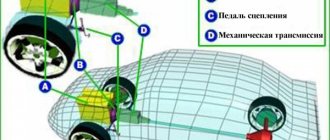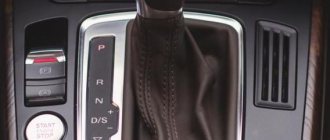If the automatic transmission is in emergency mode, this means that a failure has occurred in the box. At the same time, an icon lights up on the instrument panel, indicating that a problem has occurred. The box stops responding dynamically to pressing the gas pedal. The mode is protective. Its inclusion indicates the danger of more serious damage. At the same time, you can drive your car on your own to the nearest repair station. However, it is not allowed to operate the vehicle for a long time in this condition.
Causes
The automatic transmission goes into emergency mode due to the following reasons:
- Insufficient oil in the box. If it escapes through the gaps formed, the gearbox signals a problem.
- Problems in the operation of hydraulic devices.
- Damage to the box body.
- Wear of friction clutches.
- Problems with the electronic control system.
Sometimes when cold, the automatic transmission works normally, but when it warms up it goes into emergency mode. The culprit is a faulty temperature sensor. If the box unexpectedly enters this state, the cause may be an ordinary electrical wiring break.
Possible causes and solutions
Now that you have learned what an “emergency light” is, let’s look at the reasons why the automatic transmission goes into this very emergency mode. And there can be many reasons, from trivial to serious.
Transmission fluid level
The automatic transmission may go into emergency mode due to a low lubricant level. A lack of ATF in the box can lead to malfunctions of mechanical parts.
For example, blood pressure drops. This means that valves and clutches cannot switch with natural force, as under normal pressure. The automatic transmission will either delay changing gears or jump from one to another.
Such oil quickly becomes clogged with wear products. Rubbing parts are not properly covered with a protective film. Wear occurs faster. Chips and metal dust get into the liquid. The filter device is clogged.
Therefore, do not allow the ATF level in the automatic transmission to drop. Check the level every 10,000 kilometers, and after 50,000 km change the lubricant completely.
Check the automatic transmission for integrity. Leaking seals, a broken machine body - all this affects the reduction in ATF levels. Wear of the gasket between the engine and the automatic transmission is also accompanied by loss of oil.
Non-original ATF also causes the machine to fail. Therefore, buy oil in official stores and only the type that your automatic transmission needs.
Read
Why do you need neutral on an automatic transmission?
Malfunctions of the hydraulics or mechanical part of the box
If the automatic transmission is in emergency mode, check the hydraulics and mechanical parts. Clogged valve tracks in the valve body also lead to failure of the automatic transmission, as does a low oil level.
Wear of clutches and steel discs leads to oil contamination and the domino effect is activated. Gradually the remaining parts of the machine break down. If you do not pay attention to the problem in time, you will send the box for major repairs a month after the first signs of problems appear.
If the automatic transmission fails immediately after warming up to operating temperature, then the fault is in the temperature sensor.
If the pump wheel fails or the turbine blades are broken, the automatic transmission reactor will not work. Since the oil pressure required for normal operation will drop. There will be no pressure - gear shifting will become tense or simply impossible.
Incorrect operation of the electronic control system
The ECU forces the emergency mode to be activated due to damaged cables or contacts, when the signal about the correct functioning of the automatic transmission components does not reach it.
Faulty solenoids also cause the machine to go into an inoperative state. But we will talk about them in more detail in the next block.
Malfunctions in the crankshaft, throttle, and air sensors lead to the automatic transmission constantly being in a faulty state. Such problems can only be diagnosed using a scanner and a computer with special software.
If you hear a dull knock when the selector lever is switched to the “Forward” position, this means that the input or output shaft rotation sensor has failed. You will find information on how to fix an error with the input or output shaft rotation sensor in this article.
Read
Do-it-yourself complete and partial oil change in automatic transmission AL4
If the automatic transmission goes into emergency mode and does not want to come out of it at all, even after resetting the error, then the fault lies in the automatic control unit itself. In this case, only replacing the device with a new one will help.
Write in the comments what problems you encountered when your automatic transmission was faulty.
Automatic transmission solenoids
The reasons why the transmission fails may lie in faulty solenoids. Solenoids are very sensitive to oil quality and pressure. Therefore, both experienced mechanics and I recommend paying special attention to the original lubricant for automatic transmissions.
Automatic transmission goes into emergency mode after warming up
This can be observed when accelerating a car or driving under a heavy load. The reason is a malfunction of the temperature sensor, which gives incorrect information by degrees. This malfunction can be eliminated by replacing the element.
Renault Simbol, Laguna and Duster
On such cars a box is installed - Dp0. In some cases, it enters the emergency situation. The sign “Gearbox Fault” lights up on the instrument panel. To fix the problem, it is necessary to replace the pressure solenoids. If one element fails, then it doesn’t matter, it’s better to do the procedure in pairs. Later you will not have to disassemble the unit again.
Subaru Legacy
The reasons may be as follows:
- Torque converter slipping. It slips. The node is changing.
- Stuck or soured solenoids. New elements are being installed.
- The need to adjust the throttle sensor.
If such actions do not lead to anything, you need to remove the negative terminal of the battery for 2-3 minutes and conduct a self-diagnosis of the automatic transmission.
Mini Cooper R56
An error message appears on the computer. Gears are engaged no higher than third. The following steps must be taken:
- check ATF level;
- view the error code.
Sometimes adding fluid to normal helps. In the worst case, the valve body needs to be replaced. H3: Peugeot 206, 307 and 308
Al4 box installed. When the mode is turned on, problems may include oil, solenoid valves or cooling. Sometimes the lack of liquid in the expansion tank leads to the inclusion of this mode. To eliminate the phenomenon, the amount of antifreeze must be added to the level. Then everything will return to normal.
BMW E39
Causes:
- The lambda probe has broken down. This is a rare malfunction and not all technicians can immediately find it.
- Error 98 is displayed, which means the crankshaft speed sensor is faulty. The element requires replacement.
- Control unit malfunction. It is necessary to look for the cause of the breakdown.
Many of these defects are associated with overheating of the box.
Almera G15
Occurs when the car operates under difficult conditions, for example, during wheel slipping or emergency braking. In this case, the box may be in good condition.
To remove the unit from this state, you need to turn the ignition key to the OFF position and wait for 3 seconds. Then set it to position M. Afterwards the box should return to working condition. If not, then the failure is more serious and the unit will need to be disassembled.
Hyundai Santa Fe 2 and Solaris
The activation of the emergency state may occur as a result of failure of valve No. 75. It is located behind the intercooler. After disassembly, it can sometimes be cleaned. If this cannot be done, the element should be replaced. After installing a new valve, the mode must be unlocked.
Audi 80 B4
May be due to a faulty oil temperature sensor. It is located on a cable that requires replacement. After installing the new element, the error is fixed.
Skoda Octavia
The box is malfunctioning due to the failure of the torque converter. Sometimes occurs due to electrical failure. It is necessary to remove the pan and replace the solenoid if it is burnt out. You may just need to change the wire through which the signal does not pass.
Mercedes Actros and w211 w220
Enters the mode due to the destruction of the brake band, clutch or failure of the valve body. The nodes must change. After automatic transmission, you can operate it in standard mode.
What is automatic transmission emergency mode?
Now let's talk about what emergency mode is. You have probably read about these cases or have already encountered such situations when the following lamps are displayed on the dashboard monitor, which may blink or freeze in one position:
- Hold;
- Check Engine;
- A.T.
These lamps go out after restarting the engine or resetting the error by removing the wire from the negative terminal of the battery.
Attention! I do not recommend resetting errors by removing the wire from the battery terminal. This way you do not eliminate the cause, but extinguish the symptom. By the way, for us, experienced mechanics, after such a reset it is more difficult to determine the real problem.
Sometimes emergency mode may be preceded by the following symptoms:
- start and movement of the vehicle only in third gear;
- jolts and jerks when shifting gears;
- you cannot switch the transmission to parking mode or reverse speed;
- warning lights are on;
- selector vibration when idle at traffic lights.
Read
Who invented and invented the world's first automatic transmission
As soon as you see or hear one of the listed symptoms, immediately take the car for diagnostics. I strongly do not recommend continuing to drive a car with an automatic transmission in the emergency lights.
Write in the comments what you do if the box displays an error on the display?
Where should you start diagnosing?
Only early model automatic transmissions did without an electronic component. All other units have an electronic “brain” and a self-diagnosis system, depending on the model and year of manufacture of the automatic transmission. If the automatic transmission in your car has failed, you should start with computer diagnostics. You will need a device to connect to the diagnostic connector and appropriate software to read the information. Once you've read the actual trouble codes, look up the trouble codes online to have a clearer idea of where to look. The most common causes of automatic transmission failure are
- Incorrect ratio of individual gears;
- malfunctions in the electrical circuit of the solenoid valve;
- Mismatch between the rotation speed of the input and output shafts in the transmission.
If the solenoid valves are faulty, do not rush to disassemble the automatic transmission. It is necessary to diagnose the wiring and the automatic transmission ECU. If you know how to use a multimeter, you can easily check the resistance of the wires and the shaft rotation sensor. You will need to remove the connectors from the transmission housing, as well as the automatic transmission control unit connector. Check the wires not only for breaks, short circuits to '-', '+', but also for short circuits with each other. This can happen if the insulation is damaged or melted. Also check that the control unit connector is “live” and that there is a good “ground” connection. Refer to your vehicle's owner's manual for information on control locations, connector pinouts, and wire colors.
Visual inspection and soldering of contacts
When searching for the cause of an automatic transmission malfunction, you need to pay attention not only to the wiring harnesses where they come into contact with the body, but also to the power connectors themselves. It happens that due to corrosion or careless dismantling/installation, the contacts in the connectors simply break. An automatic transmission can go into failure mode even if there is oxide on the wheels.
In many Audis and Mercedes, the automatic transmission is located under the front seat, where it often gets wet. Before disassembling the automatic transmission, it is advisable to remove the ECU board. Even if it does not contain oxides, we recommend making sure that there are no microcracks in the soldering areas and, if necessary, desoldering the main contacts.
To disassemble the gearbox for damage to the hydraulic unit, check solenoids, friction packs, we recommend disassembling only after checking all electrical circuits and easily accessible components.
Reasons for the box going into emergency mode
Modern automatic transmissions are complex mechanisms. Unlike their predecessors, modern models are closely connected to the engine, controlled electronically and have a lot of sensors and protections.
The first and most common reason for the automatic transmission to go into emergency mode is an abnormal oil level. Occurs due to a leak in the automatic transmission, oil overflow or abnormal operation of the valve body. If we are not talking about the valve body, it is easy to fix. Leaks in an automatic transmission can be either mild or serious - for example, damage to the automatic transmission housing or the gasket between the engine and the automatic transmission has failed.
Emergency mode occurs due to a leak in the automatic transmission
Such repairs will not be cheap. In mild cases, some kind of gasket or seal is usually responsible for the oil leak.
A low oil level in the box is very dangerous. Some gearbox units stop lubricating normally and begin to wear out, contaminating the entire automatic transmission with their fragments. Other units begin to overheat and this also does not have the best effect on them. As a result, a chain reaction occurs - the weakest and most distant parts break, then all the rest. High oil levels are also dangerous. In the best case, excess oil will be released through the breather. At worst, it will foam and simply lose its properties, leading the automatic transmission to the same picture as with oil starvation.
This can also include the operation of an automatic transmission on “non-native” oil. Some automatic transmissions are so optimized and tuned that they simply cannot operate on oil with slightly different characteristics. The second reason is that the self-diagnosis system detected problems with the hydraulic or mechanical part of the automatic transmission. Most often this is wear of the friction clutches. The electronic diagnostic system will be able to correctly indicate a breakdown only in some cases. In any case, you will need to remove the box and inspect its insides for wear and damage.
One of the reasons for automatic transmission emergency mode is problems with the hydraulic part
Worn clutches will quickly cause the oil to burn, it will saturate the remaining clutches and at one point the automatic transmission will “stop” completely until it is drained. Broken gear teeth or worn-out metal parts will quickly damage neighboring ones, and where one small part needed to be replaced, the entire transmission will have to be changed.
The third reason is a malfunction of the electronic control unit, wiring or sensors. And this is the real scourge of modern automatic transmissions. Most often, this is a bad contact of one of the cables. Most of the contacts in an automatic transmission are very small and thin wires, tracks less than a millimeter thick and cables thinner than a sheet of paper. Damaging such wiring is as easy as shelling pears. Such a small nuisance, in addition to emergency mode, can also give serious symptoms in the form of kicks, jerks, slipping and loss of gears. The transition to emergency mode in this case is chaotic. The automatic transmission can drive safely for a week, but on the weekend it goes into emergency mode on every bump.
A worse option is worn valve body channels. Dirty oil eventually clogs the hydraulic platen channels, jamming the plungers. Or some seal begins to leak.
Dirty oil contaminates the hydraulic plate channels
The result is the same - the valve body goes crazy and opens the valves to the fullest, starting to drive a huge amount of oil through itself. Oil filled with metal fragments acquires properties similar to sandpaper. The aluminum channels of the hydraulic plate wear out very quickly, and very soon the hydraulic unit receives damage that is incompatible with its future life. The abnormal pressure that it begins to supply to the box is also not good for it. A chain reaction begins, which ultimately leads to expensive repairs.
If the automatic transmission switches to emergency mode only when it is cold or hot, the problem may be in the temperature sensor.
When you engage forward gear, the transmission goes into trouble due to a failure of the input or output shaft rotation sensors.
If the box does not exit emergency mode at all, the electronic control unit is most likely damaged.
The most disgusting thing about such breakdowns is the enormous difficulty of diagnosis. The vehicle's self-diagnosis system may not indicate the cause at all. And local experts will shrug their shoulders, offering to change one thing or another. And the reason for everything will be a small torn wire in the very depths of the valve body.
If the box does not exit emergency mode, then the electronic control unit is damaged
avtoexperts.ru
The advent of computers and electronic control systems has fundamentally changed the operation of many components in automobiles. Take automatic transmissions, for example, they not only acquired additional stages, but also began to be controlled not only by hydraulics and mechanics, but also by electronics. This introduced into the automotive dictionary the concept of emergency operation of an automatic transmission. Read - a mode in which the capabilities of the gearbox are electronically limited due to some problems. The ECU diagnoses the unit and, as it were, tells the driver that everything is bad.
In the photo - BMW automatic transmission handle
Many car owners consider emergency mode as a problem; the car only has one gear for forward and reverse, and the dynamics and comfort of movement are lost. Driving with an automatic transmission in emergency mode is very inconvenient. However, this is a protective measure; electronic systems specifically limit functionality in order to save expensive components if something does not work as expected. Emergency mode is needed not to drive further, but to slowly get to the repair site on your own without calling a tow truck.
Drivers do not like emergency mode because of the complexity of diagnostics. There can be a huge number of reasons for the transition to limited functionality mode, and they can rarely be found using a scanner; most often, painstaking instrumental diagnostics are required, which requires a lot of time and effort.
An example of enabling automatic transmission emergency mode on the on-board computer
Since modern boxes are a fusion of mechanics and electronics, then the reasons that force the automatic transmission to go into emergency mode should be divided into two groups.
Mechanical problems
1. Incorrect oil level . The transition to emergency mode can be caused by either excess or lack of oil. An excess may appear in rare cases, for example, when the service team overdid it during replacement, but there are more than enough reasons for leaks. The pan was broken, the gasket or seal was leaking, it was squeezed out through the breather. It’s good if the automatic transmission has a dipstick for monitoring, the car owner can assess the oil level himself, there will be no questions even if there are fresh leaks, but still, in some cases, without service you won’t even be able to check the oil level in the box. The repair here is simple: eliminate the cause of the leak and top up to the level.
Automatic transmission oil level
2. Breakdown of mechanical elements . The electronic diagnostic unit itself cannot visually assess the wear of various components, but based on sensor readings, it may well be able to figure out that something in their “mechanics” is not working correctly. Most often, the problem turns out to be in the clutches, although it could just as easily be a breakdown of the calipers, bushings, pressure pump, planetary gear, torque converter or valve body. This is just a very nasty group of reasons. Electronic diagnostics here turn out to be weak; to identify problems, the box must be dismantled and disassembled. And this requires a lot of time and financial costs. The most annoying thing is that a mechanical breakdown can happen unexpectedly, and you won’t be able to prepare for it and lay out a “straw.”
Automatic transmission clutches
3. Wear of mechanical elements . The problem is almost the same, wear and tear differs only in suddenness. Wear and tear is not a one-time thing; a “tired” box will signal problems sooner. There will be difficulties in shifting gears, jerking, additional noise and smells, and increased fuel consumption. The emergency mode on such automatic transmissions may turn on periodically, then disappear for some time, but in any case, this will be an excellent signal that repairs cannot be delayed any longer, automatic transmission problems need to be solved more quickly.
Automatic transmission valve body
Electrical problems
With electronics it is easier and more difficult at the same time. Diagnosing electronic problems does not always require removing and disassembling the box; you can often determine the problem using built-in testing tools. However, electronics have the scourge of irregularity and unsystematicity; sometimes finding a simple but floating fault can be more difficult than disassembling the automatic transmission and seeing with your own eyes all the flaws in the mechanical part.
1. Sensor malfunction . To operate the ECUs of modern automatic transmissions, they use a lot of data from sensors. Moreover, the sensors are not only in the box, but throughout the car. Once a device malfunctions or even falls off, the result can be unpredictable. In this case, emergency mode may suddenly appear and disappear suddenly without any logic. Fortunately, sensor problems can usually be successfully diagnosed by scanners combined with common sense.
Automatic transmission selector position sensor Ford Focus 2
2. Wiring problem . Another group of extremely nasty problems. Oxidized contacts, broken wires, broken insulation - everything falls into this group. The problem can be either permanent or floating, which is why diagnostic success cannot be determined in advance. In rare cases, the ECU itself will be able to indicate the problem, but usually such breakdowns are solved by boring electrical circuits. Considering the number of different chips and wire connections, the procedure may not be quick.
3. Damage to the pressure regulator and solenoids . The problem is at the intersection of electrical and mechanical, usually leading to a constant emergency mode; diagnostics are complex. Often the direction of the search can be determined by a scanner check, but the specific culprit must be searched for mechanically, checking suspicious elements.
Pressure regulator solenoid
In the generalized scheme, emergency mode is caused by precisely such problems, but depending on the specific automatic transmission model, there may be some specific problems with certain sensors or elements. If you are going to diagnose your automatic transmission, then it would be a good idea to familiarize yourself with its design in advance, and if you choose a service for work, stop at a specialized office that works with automatic transmissions of certain brands.
In general, the emergency mode of an automatic transmission is not a death sentence, moreover, the problem may turn out to be a trifle, but in any case, this is a signal that you need to take a closer look at the “automatic”, perhaps irreversible processes have already begun there, which, with further operation, even in gentle emergency mode, can finally finish off the unit.











